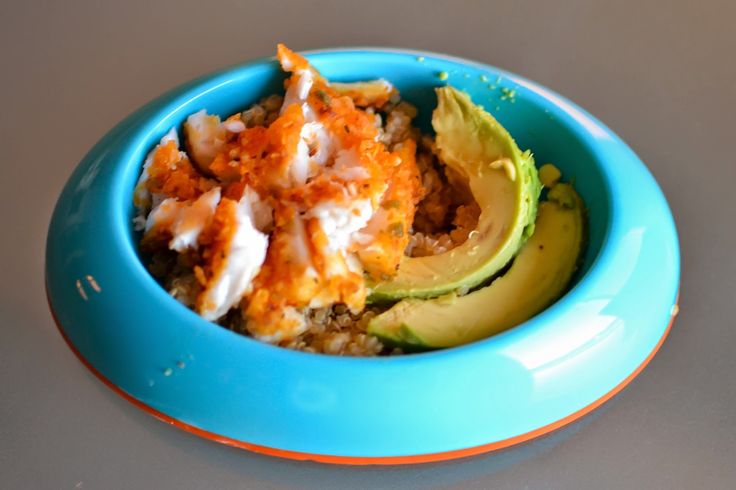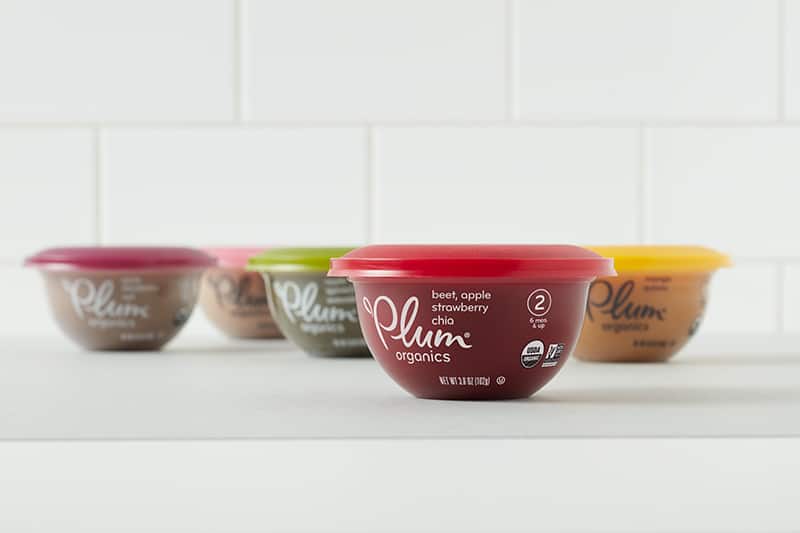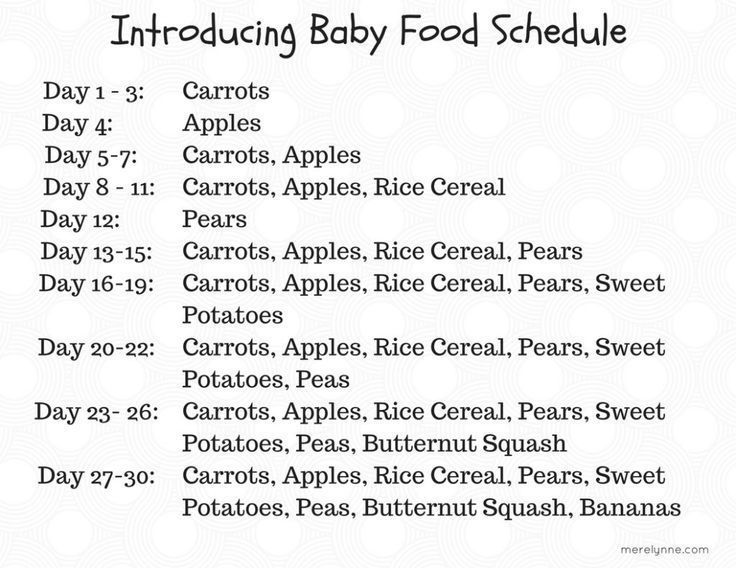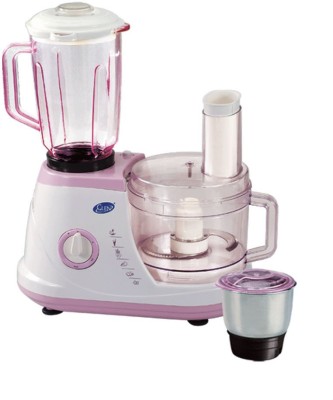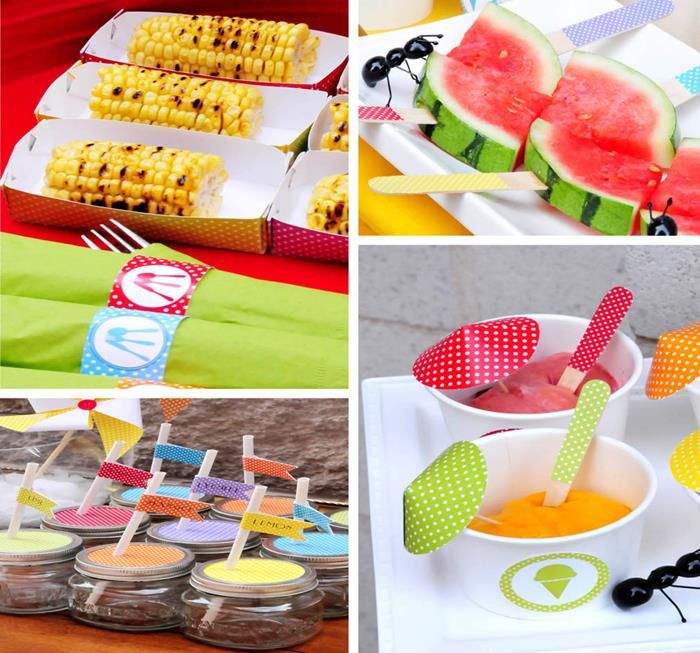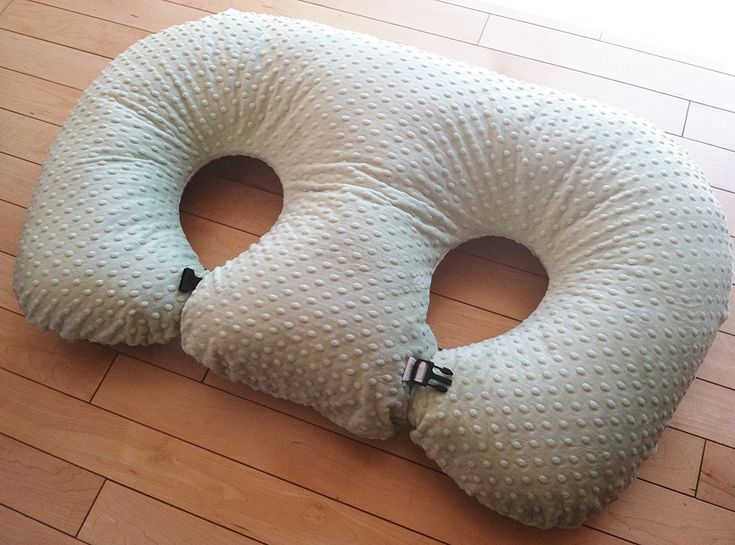Foods for eight months baby
Top Foods for 8 Month Old Baby
Here's everything you need to know to feed your 8 to 9 month old baby, including how much milk and solid food to offer as well as best foods.
There are three methods of starting solids. You may have exclusively served purees, chosen to do finger foods baby led weaning style, or taken the combination approach.
Regardless of which feeding method you chose, by 8 months, 9 months at the latest, your baby's meals should look like what I'm about to share.
So let's dive in!
Jump to:- Frequently Asked Questions
- Feeding Schedule
- How to build a well-balanced plate
- Real Life Examples
- Tips for Graduating from Purees
- Best Baby Foods for 8-9 Months
- Tips for Helping your Baby Eat
- What Foods to Avoid
- Favorite Feeding Tools
- Additional Resource
Frequently Asked Questions
How many meals should an 8 month old baby eat?
By eight months, your baby should be eating at least two meals a day. Some suggest three meals at this age, but again, every baby is different! There’s no need to force your baby to eat 3 meals a day when they’re simply not interested or hungry for it.
Two meals are plenty! You will also save yourself a lot of frustration by following your baby’s cues.
Some even suggest serving three meals and a snack. I want to reassure you that your baby does NOT need a snack until closer to 1 year of age. And even then, your baby may not be interested. Did I just hear a sigh of relief?
What’s more important than making sure your baby gets x amount of food is you creating a positive and relaxing mealtime experience for your baby.
If you are frantically trying to get food on the table and not able to enjoy sharing a meal alongside your baby, they will absolutely sense that, which can negatively affect their ability to eat.
Both of my babies weren’t ready for 3 meals until around 9 months, my son even later because he was born prematurely. But they did great with those 2 meals.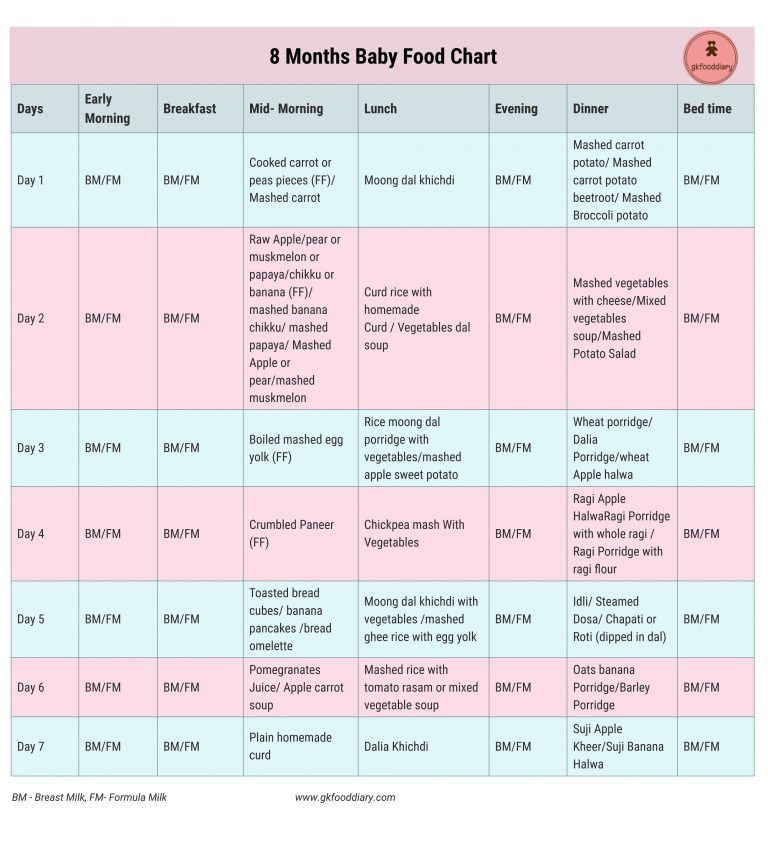 And I enjoyed not having to prepare yet another meal for a little while longer ;).
And I enjoyed not having to prepare yet another meal for a little while longer ;).
I encourage you to always have your baby join you at the table so you will know when they’re ready for that last meal. If they start smacking and reaching for your food, they’re most likely ready.
I know that was a long answer, but to state simply, your baby should be eating at least 2 meals a day, working towards 3 meals by 9-10 months.
How much milk does a 8 to 9 month old need?
Milk, whether it's breast milk or formula, is and will continue to be the most important part of your child's diet up until they turn one.
At this age, daily milk intake should be around 25-32 ounces and if you are nursing, about 4-6 times a day. But keep in mind, every baby is unique. The best thing you can do is use these recommendations as a guide, but follow your baby's lead first and foremost.
It becomes a bit more challenging to do so when giving milk in a bottle because you can see exactly how much your baby drinks.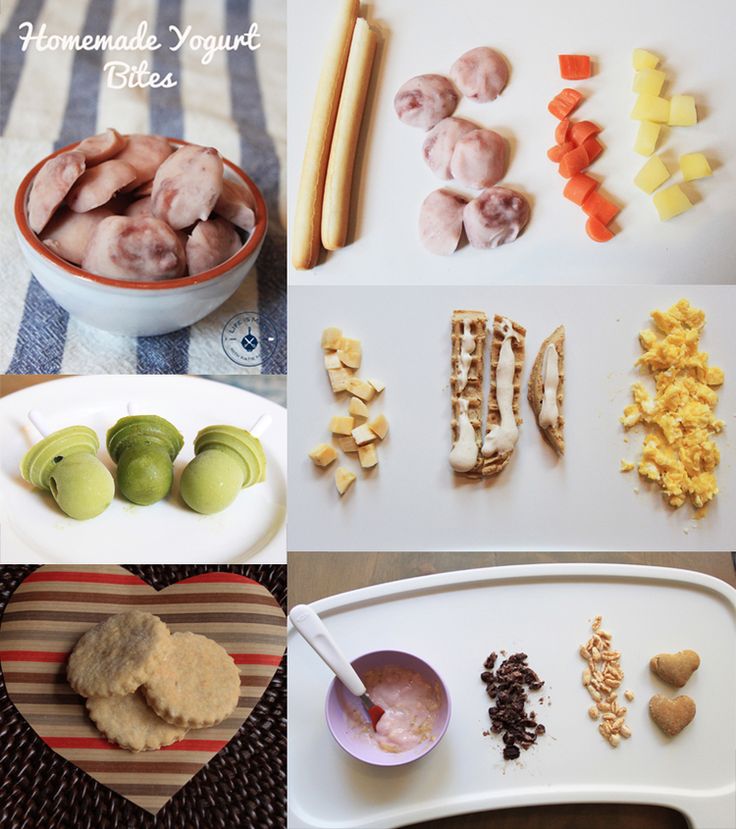 It's so easy to get caught up with the numbers. If your baby is turning away, don't force them to finish the bottle.
It's so easy to get caught up with the numbers. If your baby is turning away, don't force them to finish the bottle.
Trust their innate ability to self-regulate. Just like how you eat different amounts of food each day, it's NORMAL for your baby to drink different amounts at each feeding.
Your baby may start to drink less as they begin eating more solid food, and that's to be expected. Weaning is a gradual process. Continue to offer milk before meals and stay in tune with your baby's cues.
How much solid food should an 8 to 9 month old eat?
The American Academy of Pediatrics recommends that your baby consume between 750 and 900 calories each day, of which about 400-500 should come from breastmilk or formula.
Now I don’t know about you, but as someone who struggled with an eating disorder for a long time, I don’t want to count calories, not even for my baby. Also, it totally goes against the baby led approach, which is to TRUST and follow your baby’s innate ability to self regulate.
Just because you offer x amount of food, doesn’t mean your baby is going to eat it all. And neither should you force them to clean their plate. At this stage, it's still about discovery and learning about what food feels, smells, and tastes like.
Helping them develop a healthy relationship with food starts now! And our feeding practices matter. A LOT. What's even more important than the food you serve and how much gets eaten is a positive mealtime experience. Help your child stay positive and curious.
So the main takeaway is to prioritize milk feedings and consistently offer well-balanced meals that will help meet their nutritional needs. More on this below!
If your baby is growing, following their unique growth curve, and happy, they are eating the amount of food that’s RIGHT for them, even if it’s less or more than the recommendations or what you think they need to be eating.
Does an 8 month old baby need water?
While water may be introduced to 6 month olds and older, it is not necessary.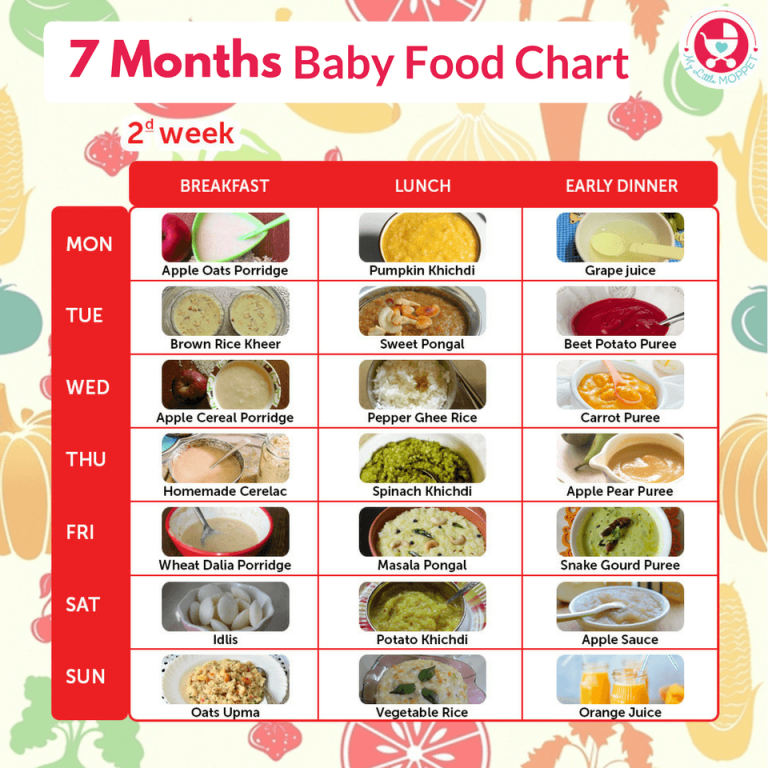 Breastmilk or formula will be enough to meet their hydration needs. As long as your baby is having regular wet diapers, there's no need to worry.
Breastmilk or formula will be enough to meet their hydration needs. As long as your baby is having regular wet diapers, there's no need to worry.
However, you may want to offer sips of water (no more than 2-3 ounces/day so it doesn't displace milk) to help them practice cup drinking and to get used to the flavor of water.
Drinking from a cup is a lifelong skill, and by introducing early, it will give them plenty of time to explore and practice. Yes, it’s going to be messy but will be well worth it when it comes time to transition your baby from the breast or bottle.
By then your baby will have the skills to drink independently and will easily be able to make the shift.
Keep in mind the goal at this stage is not to get them to drink a large amount of water. It is practice practice!
Feeding Schedule
I want to start off by saying that having a schedule doesn't mean you have to be super rigid with it. There's always room for flexibility.
Babies thrive on predictability and routine, and it can also help you to plan your day accordingly.
In terms of when you should offer your baby their meals, it's really up to you! For us, mornings are hectic, not to mention baby drank a lot of milk upon waking, so we started with lunch, then dinner, and added breakfast last.
Even though we are mainly talking about food, let's not forget that sleep is a very important piece to all of this. A well-rested baby means a happier baby who will be more interested in exploring the world of food.
I'm sharing our schedule to give you an idea of how to fit in two meals along with milk and nap times. You will notice this pattern - eat, play, sleep.
- 7 am - wake up and milk
- 9-10:15 am - Nap 1
- 10:20 am - Milk
- 11 am - Meal #1
- 12:30-1:30pm - Nap 2
- 1:35 pm - Milk
- 3:30-4:30 pm - Nap 3
- 4:35 pm - Milk
- 6 pm - Meal #2
- 6:30 pm - Milk
- 7 pm - bedtime
How to Cook the Softest Scrambled Eggs for Baby
What does a well-balanced plate look like in practice? With so many food choices, serving meals that will help meet your child’s nutrient needs can feel overwhelming.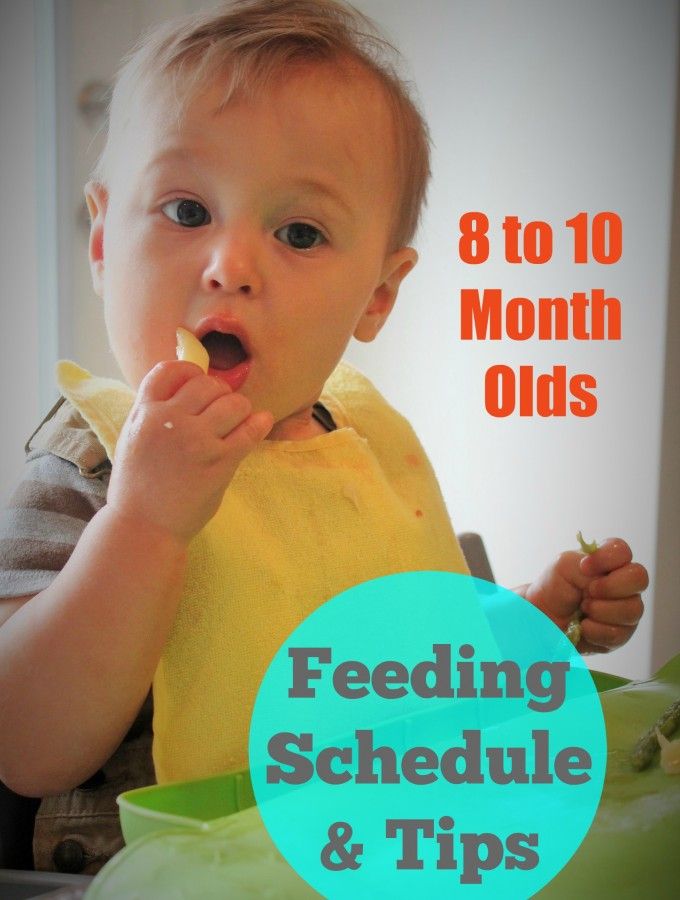 Please allow me to simplify and make this goal achievable and fun.
Please allow me to simplify and make this goal achievable and fun.
- Offer one high-iron food at each meal
- Offer one high-energy food at each meal
- Fruits/vegetables
I want to elaborate a little bit on high-energy foods. Think carbohydrates and fats. Some examples include nuts and seeds, avocado, full fat yogurt, grains, bread, etc.
Fat is an essential nutrient at this age for optimal brain development and growth. And these calorically dense foods are a great way to make every bite count.
You’ll notice that some of the foods overlap. For instance, avocado is a fruit but it’s also a high-energy food or beans are a good source of iron but also a vegetable. Simply decide which category you want the food to count as and fill in the rest.
In terms of the amount, start with small portions to make it less overwhelming for your baby. This will also reduce food waste. You can always offer more if they seem interested.
Real Life Examples
Here are some meals I served to my baby.
- Tofu Veggie Scramble Oatmeal Balls
- Iron food - tofu, beans
- High-energy food - oatmeal
- Vegetables - bell peppers, zucchini, onion
- Quinoa (iron) with avocado (high-energy), purple cauliflower (vegetable)
- Beef Stroganoff
- Iron food - beef
- High-energy food - pasta
- Vegetables - carrots, bell peppers, mushrooms, peas
- Turkey beet meatballs (iron), Avocado rolled in flax seeds (high-energy), Broccoli (vegetable)
Regardless of which feeding method you chose, the goal is that by 9 months, at the latest, your baby is being introduced to a wide variety of flavors and textures from all food groups.
That's because research shows that infants who are introduced to textures by 9 months generally have less feeding problems and greater food acceptance down the road.
If you’ve been spoon feeding, start by preloading the spoon and allowing them to pick it up themselves. There may be great resistance at first, and your baby may want you to continue feeding them. But stand strong.
There may be great resistance at first, and your baby may want you to continue feeding them. But stand strong.
Your baby will eventually realize that mommy or daddy won’t feed them no matter what and begin to explore for themselves.
Also, it’s completely normal for your baby to start eating less during this transition. Managing textured foods is a whole new experience, and your baby will need some extra time to learn the skills to handle them.
And they will when given plenty of opportunities to do so. Therefore, don’t fall back on purees. Keep marching forward. In the meantime, you can increase the amount of milk feeds.
For more tips, here's an in-depth post on how to transition from purees to table foods.
Best Baby Foods for 8-9 Months
By this age, your baby is working on developing their pincer grasp, which involves using the thumb and the index finger to pick up small pieces of food. You can start serving bite-sized pieces to help practice this new skill.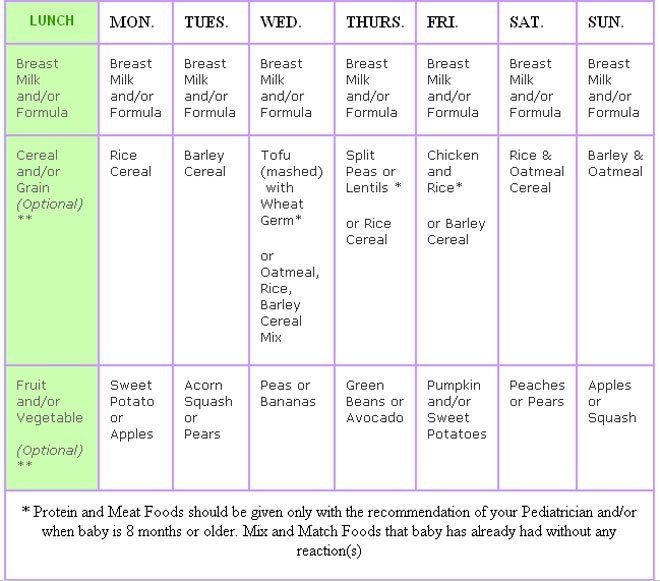
But do continue offering big pieces of food to minimize frustration and to allow for practice with taking bites.
Iron-rich foods
I've dedicated a whole post to this along with recipes! I believe you will find it extremely helpful.
Best iron-rich foods for babies
High-energy foods
- Avocado
- Oatmeal
- Nuts and Seeds
- Lentils
- Quinoa
- Yogurt
- Bread
- Pasta
- Muffins
- Dips/Sauces
- Waffles
- Pancakes
Best Weight Gain Foods for Babies
Fruits and Vegetables
- Butternut squash
- Sweet potatoes
- Beetroot
- Cauliflower
- Broccoli
- Bell peppers
- Mashed peas
- Zucchini
- Carrots
- Cabbage
- Mushrooms
- Parsnip
- Mango
- Apple
- Pear
- Banana
- Kiwi
- Berries (strawberries, raspberries, blueberries), smashed)
- Watermelon
- Peaches
When cooking vegetables, don't forget to season with herbs and spices!
Tips for Helping your Baby Eat
- Offer meals when your baby is happy and seems interested in eating.
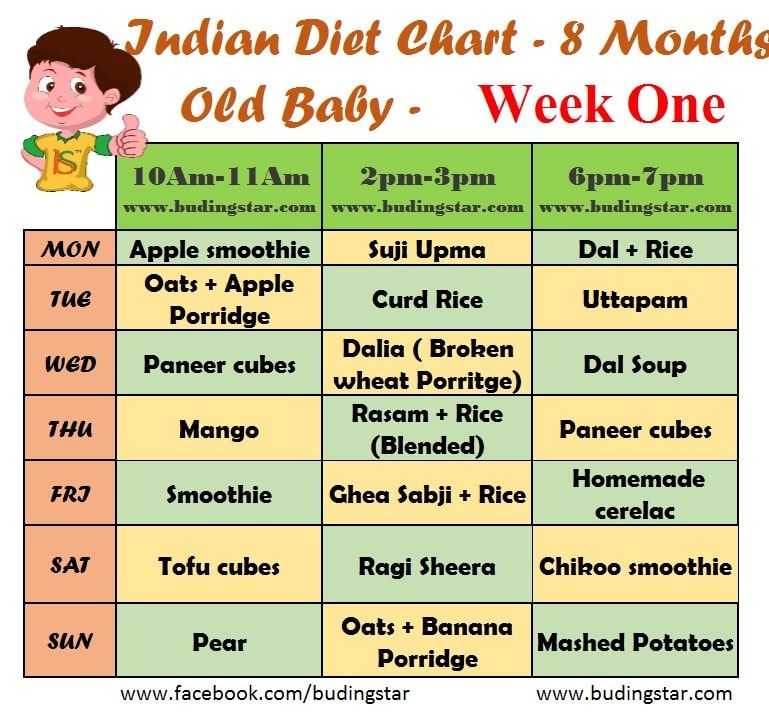
- Make sure foods are soft and easy to smash with your fingers.
- While their hands will be their best tools for quite some time, offer utensils from the beginning for exposure and familiarity.
- Don’t be afraid to season the food with a wide variety of herbs and spices. It’s such a delicious and easy way to expose them to all the different flavors. Hold off on salt!
- For foods that are harder to pick up, like rice and quinoa, mash with some sweet potato or avocado to make them easier to eat.
- Your baby may still be doing a lot of playing and throwing at this point, and that’s ok. They are still learning to self feed and it’s a skill that takes A LOT of practice. So be consistent and patient. Stick to your mealtime schedule and eat alongside your baby so they can watch and learn from you.
- If your baby doesn’t eat much during mealtime, you can offer a little bit of breastmilk/formula afterwards.
What to do when baby doesn't eat
What Foods to Avoid
- Hard or crunchy texture - raw fruits and vegetables, whole nuts, crackers, popcorn, etc.
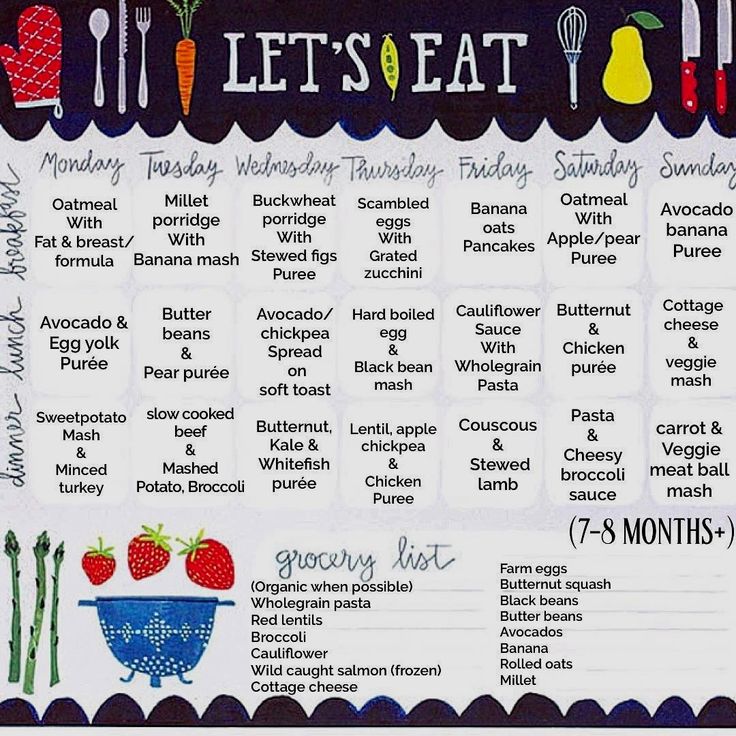
- Sticky texture - a glob of peanut or nut butter
- Honey until 1 year as it can lead to botulism - it’s unsafe even if it’s uncooked. Be sure to read the labels as it’s an ingredient in a lot of unexpected foods.
- Unpasteurized milk, yogurt, cheese, or juice (which should be avoid until 2)
- Milk for drinking (can be used in recipes)
- High-sodium foods
- Added sugars
Favorite Feeding Tools
Here are the essentials that I know will save you time and your sanity! I know it’s tempting to buy all the adorable products that are out there. But truly, these are really all you need!
Additional Resource
If you are struggling to move beyond purees or feeling overwhelmed trying to give your baby the best, here's a complete roadmap that would show you through daily videos and photos of what foods and how to serve them to your baby AND the rest of the family at the same time!
Baby formula feeding chart: How much formula by weight and age
Is your baby getting too much or too little formula? It's an important question that worries many new parents, especially those with newborns. When deciding how much formula to give your baby, it's important to watch their hunger cues as well as looking at guidelines based on age and weight. In general, before they're eating solids, babies need 2.5 ounces of formula per pound of body weight each day.
When deciding how much formula to give your baby, it's important to watch their hunger cues as well as looking at guidelines based on age and weight. In general, before they're eating solids, babies need 2.5 ounces of formula per pound of body weight each day.
These guidelines are for babies who are exclusively formula-fed for the first 4 to 6 months, and then fed a combination of formula and solids up to age 1. If your baby is getting a combination of breast milk and formula, talk to their doctor for separate advice.
Your pediatrician can tell you where your baby falls on the growth charts, make sure they're growing steadily on their own growth curve, and help you ensure that they're getting a healthy amount of formula. If you're ever worried about your baby's growth, behavior, or development, talk with their doctor.
How much formula for a newborn
For the first few days, offer your newborn 1 to 2 ounces of formula every 2 or 3 hours. (At first, newborns may only take a half ounce of formula at a time. )
)
After the first few days, give your newborn 2 to 3 ounces of formula every 3 to 4 hours.
Initially it's best to feed your formula-fed newborn on demand, whenever they show signs that they're hungry. Because your little one can't tell you when they want a bottle, you'll need to learn to read their hunger cues. Crying is often a late sign of hunger, so if you can, try to catch the earlier signs that it's time for a feeding.
Here are some hunger cues to watch for:
- Smacking or licking their lips
- Rooting (moving their jaw, mouth, or head in search of food)
- Putting their hands to their mouth
- Opening their mouth
- Fussiness
- Sucking on things
- Becoming more alert
- Crying
As time passes, your newborn will begin to develop a fairly regular feeding schedule. You'll become familiar with their cues and needs, and knowing when and how much to feed them will be much easier.
Formula feeding chart by weight
During the first 4 to 6 months, when your baby isn't eating solid foods, here's a simple rule of thumb: Offer 2.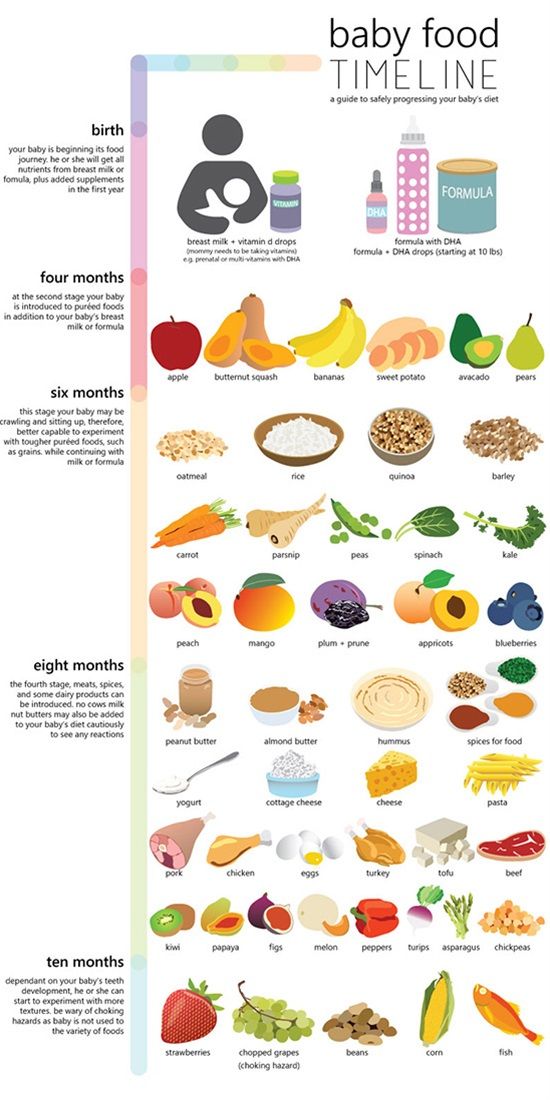 5 ounces of formula per pound of body weight every 24 hours, with a maximum of about 32 ounces.
5 ounces of formula per pound of body weight every 24 hours, with a maximum of about 32 ounces.
| Weight | Ounces of formula |
|---|---|
| 6 pounds | 15 fl oz every 24 hours |
| 7 pounds | 17.5 fl oz every 24 hours |
| 8 pounds | 20 fl oz every 24 hours |
| 9 pounds | 22.5 fl oz every 24 hours |
| 10 pounds | 25 fl oz every 24 hours |
| 11 pounds | 27.5 fl oz every 24 hours |
| 12 pounds | 30 fl oz every 24 hours |
These numbers aren't rigid rules. They offer a rough estimate for what your baby may need. Some babies will grow well while taking less than the recommended amount, while others consistently need more. Your baby's daily feedings will also vary according to their individual needs – in other words, they may want a bit more on some days and a bit less on others.
Formula feeding chart by age
Here are typical amounts per day based on age:
| Age | Ounces of formula |
|---|---|
| Full-term newborn | 2 ounces per bottle every 3 to 4 hours |
| 1 month old | 3 to 4 ounces per bottle every 3 to 4 hours |
| 2 month old | 4 to 5 ounces per bottle every 3 to 4 hours |
| 3 month old | 4 to 6 ounces per bottle every 3 to 4 hours |
| 4 month old | 4 to 6 ounces per bottle, 4 to 6 times a day |
| 5 month old | 4 to 6 ounces per bottle, 4 to 6 times a day |
| 6 month old | 6 to 8 ounces per bottle, 4 to 5 times a day |
| 7 month old | 6 to 8 ounces per bottle, 3 to 5 times a day |
From 8 months old until their first birthday, you can expect your baby to have 7 to 8 ounces per bottle, 3 to 4 times a day.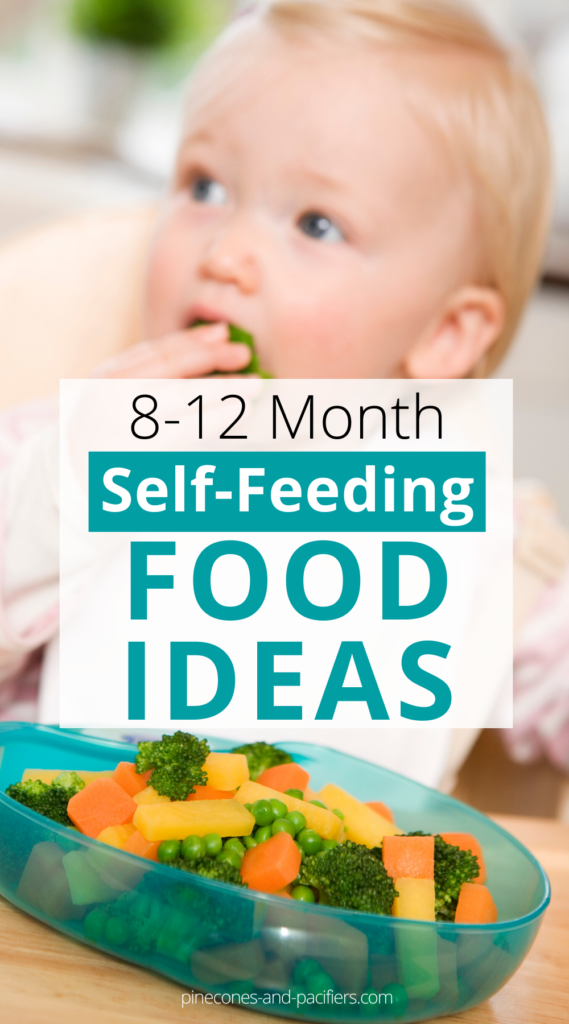
As your baby gets older – and their tummy gets bigger – they'll drink fewer bottles a day with more formula in each. It's important not to overfeed your baby so they'll stay at a healthy weight. Your baby shouldn't have more than 32 ounces of formula in 24 hours.
When they reach their first birthday, they can stop drinking formula and transition to cow's milk in a bottle, sippy cup, straw cup, or open cup. Limit your toddler to 16 to 24 ounces (2 to 2.5 cups) a day of whole milk, so they have room for other healthy foods.
Signs that your baby's getting enough formula
Here are signs that your baby's getting all the formula they need:
- Steady weight gain. They continue to gain weight after their first 10 days and follow a healthy growth curve during their first year. (Most babies lose up to 7 to 10 percent of their birth weight in the first few days and then regain it by the time they're about 2 weeks old.)
- Happy baby.
 They seem relaxed and satisfied after a feeding.
They seem relaxed and satisfied after a feeding. - Wet diapers. They wet two to three diapers a day in the first few days after birth. Over the next few days, the amount should increase to at least five to six wet diapers a day.
Signs your baby's getting too much formula
Babies are usually good at eating the amount they need, but bottle-fed babies can drink too much at times. Here are the signs that they're getting too much formula:
- Vomiting after a feeding may be a sign that your baby had too much. (Spitting up is normal, vomiting isn't.)
- Tummy pain after a feeding can also be a sign of overfeeding. If your baby draws up their legs or their tummy seems tense, they may be in pain. (See other possible reasons for stomach pain in babies.)
If your baby seems to want to eat all the time, even after finishing a bottle, talk to your pediatrician. Using a pacifier may help soothe their need to suck.
Formula-feeding tips
- In general, babies eat when they're hungry and stop when they're full, so resist the temptation to encourage your baby to finish each bottle. Overfeeding during infancy can contribute to obesity later in life.
- Don't respond to your baby's every cry with a bottle. They may be crying because their diaper is wet, they're cold or hot, they need to be burped, or they want to be close to you. (Learn more about why babies cry, and how to soothe them.)
- Your baby may be hungrier than usual during growth spurts. These typically occur 10 to 14 days after birth and around 3 weeks, 6 weeks, 3 months, and 6 months of age.
Read more:
- Formula Feeding Problem Solver
- How to safely store and use formula
advertisement | page continues below
Menu for a child at 8 months: what is possible, diet
PreviousNext
- What does a child eat at 8–9 months and what new foods should be introduced?
- What to give a baby at 8 months - what consistency should his food be?
- What diet should an eight-month-old baby have?
- What should you refrain from in feeding a child?
- Approximate menu for feeding a baby at 8 months
Contents:
The older the child gets, the more questions young parents have about feeding. The introduction of products has already begun, but what's next? What does an 8 month old baby eat? What is impossible? What to feed the baby? What is the feeding schedule? How much does an 8 month old baby eat? And if he is breastfed or artificial?
The introduction of products has already begun, but what's next? What does an 8 month old baby eat? What is impossible? What to feed the baby? What is the feeding schedule? How much does an 8 month old baby eat? And if he is breastfed or artificial?
By this age, the baby should be receiving adequate complementary foods, but breast milk and its substitutes are still the mainstay of an eight-month-old baby's diet (World Health Organization, American Academy of Pediatrics). Recall that the purpose of the introduction of complementary foods is to introduce the child to foods and new textures, teach him to chew, replenish the supply of nutrients that is missing for a growing body and prepare for the transition to a common (parental) table. By the way, do you know what a baby should be able to do at 8 months? Look in this article.
At 8-9 months, in addition to nutrients from breast milk or milk equivalents, a baby needs approximately 400 kcal, 6 grams of protein, 200 mg of calcium, 3.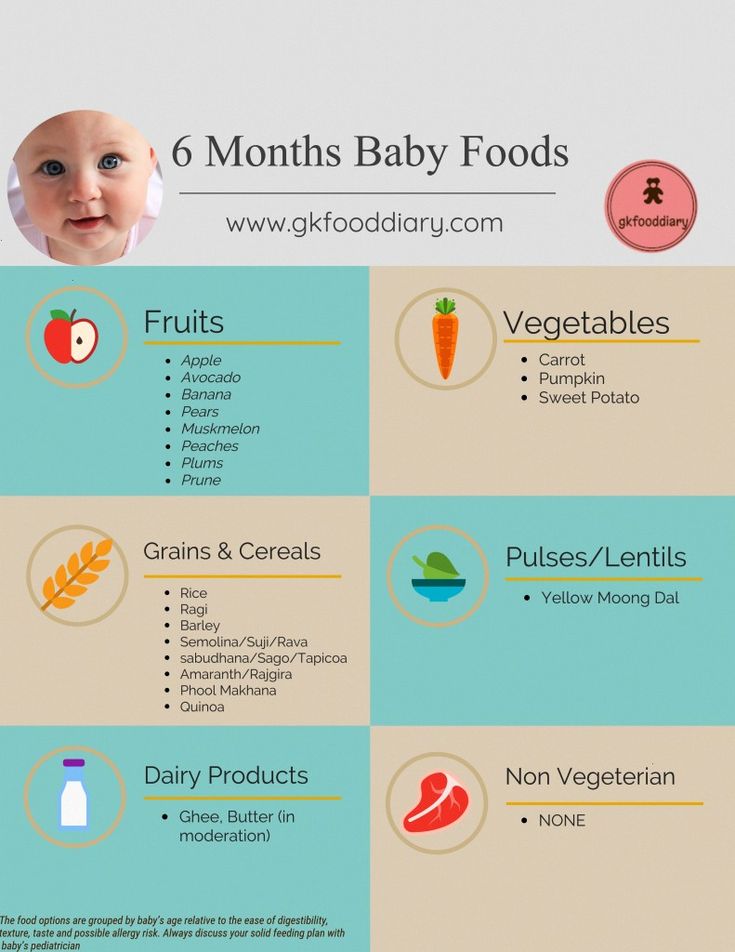 5 mg of iron, as well as fats, carbohydrates, and a range of vitamins and minerals daily, which should be supplied with complementary foods.
5 mg of iron, as well as fats, carbohydrates, and a range of vitamins and minerals daily, which should be supplied with complementary foods.
What does a baby eat at 8–9 months and what new foods should be introduced?
By the age of eight months, the baby already has a sufficient set of complementary foods: various vegetables (zucchini, broccoli, cauliflower, potatoes, pumpkin, carrots, sweet potatoes), fruits (apple, pear, banana, peach, apricot), cereals (buckwheat, rice, corn), meat (turkey, rabbit, beef, chicken), butter and vegetable oils.
Baby nutrition experts recommend that fish be introduced to complementary foods at this age as a source of omega-3 fatty acids, B vitamins, minerals and trace elements. You should start with white fish (hake, cod, perch, pollock). Serving size should not exceed 30-50 grams per serving, 1-2 times a week instead of meat dishes. Fish can be combined with vegetables or cereals.
8 months is the time to start introducing fermented milk products (kefir, unsweetened biolact or yogurt up to 150 ml per day), cottage cheese (no more than 50 grams per day) and cheese into the diet.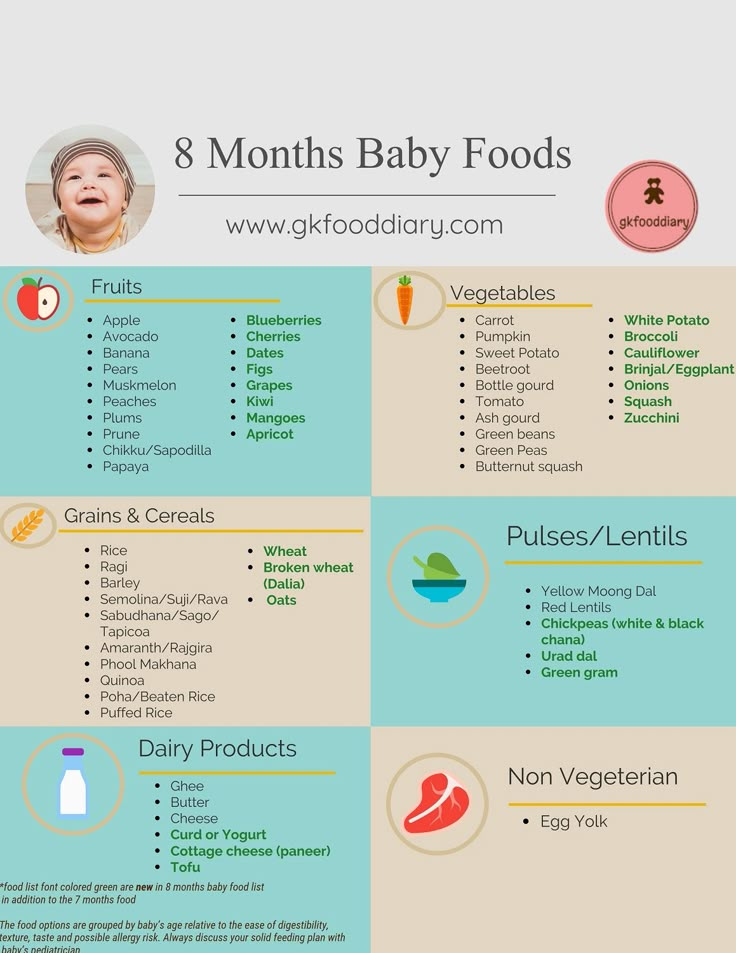 An additional source of calcium is extremely important for a fast-growing organism. In addition, lactic acid bacteria help the baby's digestion.
An additional source of calcium is extremely important for a fast-growing organism. In addition, lactic acid bacteria help the baby's digestion.
Parents often have a question: is it possible to give milk to a child of 8 months? No, WHO does not recommend doing this before 12 months due to the high risk of developing an allergic reaction.
As an additional source of fat, it is recommended to add 1 tsp. butter in cereals and 1 tsp. vegetable oil in vegetable dishes.
What to give a baby at 8 months - what consistency should his food be?
The consistency of food for an eight-month-old baby should be soft, but not homogenized - mashed potatoes, minced meat, ground on a grater. From 8 months it is recommended to introduce pieces into complementary foods: you should start with small ones, no more than 0.5 × 0.5 cm of soft consistency (for example, boiled zucchini, banana, ripe pear, etc.).
In addition to the food that the baby receives from a spoon, it is important to offer him the so-called finger food - food that the child will independently hold in his hand and eat. For example, fresh fruits cut into large pieces (banana, peach, melon) or cooked vegetables (potatoes, carrots, bell peppers). Eating on your own while holding the product in your hand is an important skill that a child must acquire at the stage of acquaintance with food. So the child will learn to bite off small pieces, chew and swallow them. In addition, it is great for training coordination and fine motor skills, and learning the texture of the product is an important part of development.
For example, fresh fruits cut into large pieces (banana, peach, melon) or cooked vegetables (potatoes, carrots, bell peppers). Eating on your own while holding the product in your hand is an important skill that a child must acquire at the stage of acquaintance with food. So the child will learn to bite off small pieces, chew and swallow them. In addition, it is great for training coordination and fine motor skills, and learning the texture of the product is an important part of development.
What diet should an eight-month-old baby have?
At 8 months, the baby should have approximately 2-3 full meals and 2-3 snacks, while breastfeeding may still be on demand.
And there are no fundamental differences between cooked food at home and in industrial conditions. Use the one that is comfortable for you.
Experts disagree about how much a baby eats at 8 months. Experts from WHO and the Union of Pediatricians of Russia recommend increasing the volume of complementary foods to 180-200 ml per feeding. However, if parents plan to continue breastfeeding, such large serving sizes may crowd out feedings, so the volume of a single serving should not exceed 120 ml.
However, if parents plan to continue breastfeeding, such large serving sizes may crowd out feedings, so the volume of a single serving should not exceed 120 ml.
What should one refrain from in feeding a child?
For a long time, fruit juice was used as the first complementary food. However, now pediatricians around the world recommend including these drinks in the baby’s diet no earlier than a year. A large amount of sugars (even natural ones) has a negative effect on the immature gastrointestinal tract of the baby, and especially on the liver and pancreas. Therefore, it is worth waiting 12 months.
Also, currently fashionable cow's milk substitutes - oatmeal, coconut, almond, buckwheat and others are of no use. Such products have a low energy value, and they only take up additional volume in the stomach.
Tea, even for children, even herbal, should also not be introduced into complementary foods at 8 months. WHO experts recommend introducing your baby to this wonderful drink no earlier than 5 (!) years.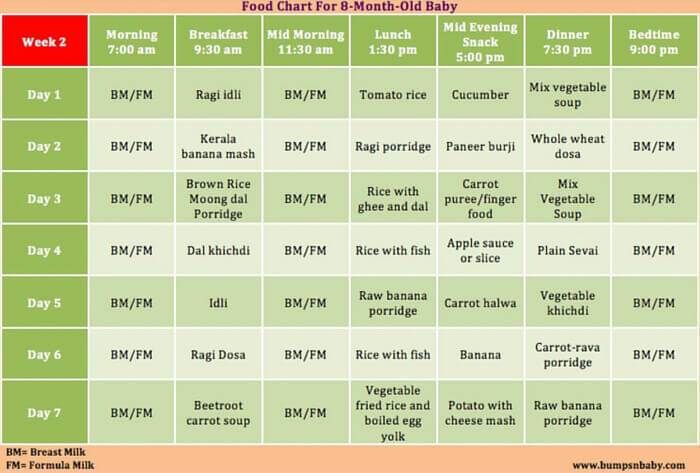
And, of course, in recipes for an 8-month-old baby, you should refrain from refined sugar (including baby biscuits), honey (risk of botulism infection), mushrooms, fatty fish and meat, sausages and sausages.
Approximate feeding menu for an 8 month old baby
In addition to breast milk or its substitutes, the diet of an 8-month-old baby is as follows.
Sources:
- https://www.pediatr-russia.ru/parents_information/soveti-roditelyam/ratsiony-pitaniya-v-razlichnye-vozrastnye-periody/vvedenie-prikorma.php
- https://www.unicef.org/parenting/food-nutrition/feeding-your-baby-6-12-months#:~:text=Start%20to%20give%20your%20baby,nutrients%20she%20needs%20without %20breastmilk
- https://open.alberta.ca/dataset/efb0a54d-5dfc-43a8-a2c0-f3a96253d17e/resource/f297828a-45c4-4231-b42c-48f4927a90d8/download/infantfeedingguide.pdf
- https://www.healthyparentshealthychildren.
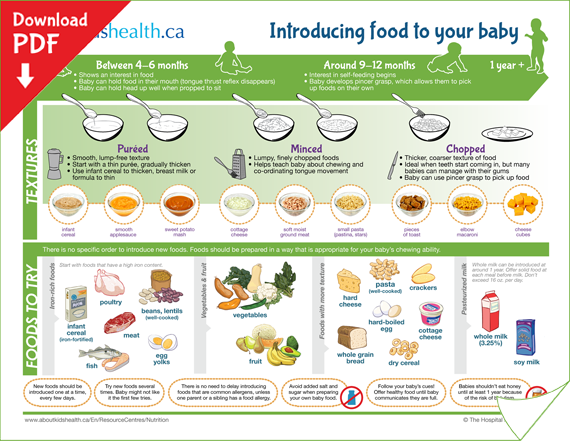 ca/im-a-parent/older-babies-6-12-months/feeding-starting-solid-foods
ca/im-a-parent/older-babies-6-12-months/feeding-starting-solid-foods
| Author: pediatrician Karina Petrova |
Diet for an 8 month old child
In the ninth month, fish can be introduced into the diet of children. Along with animal meat, fish is a source of complete protein with a well-balanced composition of amino acids, fat, vitamins B2, B12 and minerals. Compared to meat, fish contains 5 times less connective tissue, due to which it is quickly boiled soft, has a delicate texture after heat treatment and is easier to digest. Fish oil is characterized by a high content of polyunsaturated fatty acids, including the ω-3 class. These substances are necessary for the child to mature the brain, retina, strengthen the cardiovascular and immune systems. Sea fish contains such important trace elements for the child's body as iodine and fluorine. The child should be given 1-2 times a week instead of meat, be sure to monitor how the child tolerates fish in general and its individual varieties. Preference should be given to oceanic fish, preferably white (cod, hake, pollock), red salmon can be recommended, river pike perch, carp.
The child should be given 1-2 times a week instead of meat, be sure to monitor how the child tolerates fish in general and its individual varieties. Preference should be given to oceanic fish, preferably white (cod, hake, pollock), red salmon can be recommended, river pike perch, carp.
Self-cooked fish is given to a child with boiled and mashed vegetables. You can also offer your baby fish and vegetable canned food, but they contain only 10 - 20% of fish.
At this age, when all the main food groups have already been introduced, special attention should be paid to the diversity of the composition of dishes. New, possibly combined products are introduced, for example, not only purees from various fruits and berries, but also their combinations with cottage cheese, cream, cereals, etc.
From the age of 8 months, the child's diet can be expanded to include fermented milk products (baby kefir, biokefir, bifidokefir, yogurt, bioyogurt, biolact). Fermented milk products are prepared using a special starter culture that breaks down milk protein, so that the baby can get an indispensable set of amino acids in a well-available form.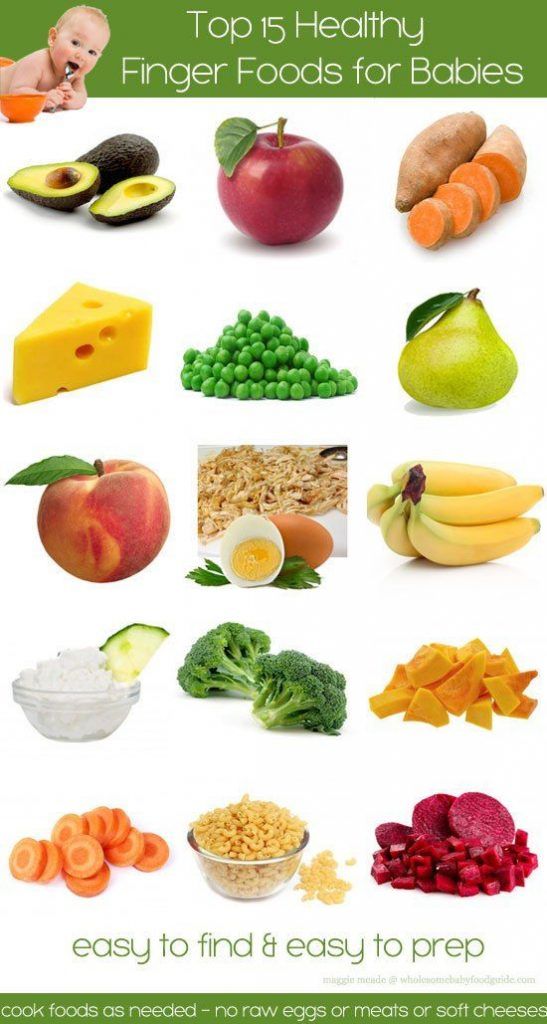 Fermented milk products improve the composition of the intestinal microflora of the child, are rich in B vitamins and calcium. Their regular use favorably affects the functioning of the intestines, stimulates appetite, and increases the absorption of micronutrients. Children's dairy products are introduced into the baby's diet gradually, starting with 1 tsp. and with good tolerance increase their volume to 150-200 ml per day.
Fermented milk products improve the composition of the intestinal microflora of the child, are rich in B vitamins and calcium. Their regular use favorably affects the functioning of the intestines, stimulates appetite, and increases the absorption of micronutrients. Children's dairy products are introduced into the baby's diet gradually, starting with 1 tsp. and with good tolerance increase their volume to 150-200 ml per day.
Sample menu for a healthy baby 8 months
| I feeding 6 hours | Breast milk or infant formula | 200 ml |
| II feeding 10 hours | Dairy-free* or milk porridge Butter Boiled egg yolk Fruit puree Fruit juice | 180 g |
| III feeding 2 pm | Vegetable puree Vegetable oil Meat puree Fruit juice | 170 g 1/2 tsp 50 g 50 ml |
| IV feeding 18 hours | Cottage cheese Baby biscuits Fruit puree Supplementation with breast milk or baby kefir/yogurt | 40 g |


